Island gigantism

Island gigantism, or insular gigantism, is a biological phenomenon in which the size of an animal species isolated on an island increases dramatically in comparison to its mainland relatives. Island gigantism is one aspect of the more general "island effect" or "Foster's rule", which posits that when mainland animals colonize islands, small species tend to evolve larger bodies, and large species tend to evolve smaller bodies (insular dwarfism). This is itself one aspect of the more general phenomenon of island syndrome which describes the differences in morphology, ecology, physiology and behaviour of insular species compared to their continental counterparts. Following the arrival of humans and associated introduced predators (dogs, cats, rats, pigs), many giant as well as other island endemics have become extinct (e.g. the dodo and Rodrigues solitaire, giant flightless pigeons related to the Nicobar pigeon). A similar size increase, as well as increased woodiness, has been observed in some insular plants such as the Mapou tree (Cyphostemma mappia) in Mauritius which is also known as the "Mauritian baobab" although it is member of the grape family (Vitaceae).
Possible causes

Large mammalian carnivores are often absent on islands because of insufficient range or difficulties in
Since small size usually makes it easier for herbivores to escape or hide from predators, the decreased predation pressure on islands can allow them to grow larger.[1][a] Small herbivores may also benefit from the absence of competition from missing types of large herbivores.
Benefits of large size that have been suggested for island tortoises include decreased vulnerability to scarcity of food and/or water, through ability to survive for longer intervals without them, or ability to travel longer distances to obtain them. Periods of such scarcity may be a greater threat on oceanic islands than on the mainland.[4]
Thus, island gigantism is usually an evolutionary trend resulting from the removal of constraints on the size of small animals related to predation and/or competition.
Territorialism may favor the evolution of island gigantism. A study on Anaho Island in Nevada determined that reptile species that were territorial tended to be larger on the island compared to the mainland, particularly in the smaller species. In territorial species, larger size makes individuals better able to compete to defend their territory. This gives additional impetus to evolution toward larger size in an insular population.[7]
A further means of establishing island gigantism may be a founder effect operative when larger members of a mainland population are superior in their ability to colonize islands.[8]
Island size plays a role in determining the extent of gigantism. Smaller islands generally accelerate the rate of evolution of changes in organism size, and organisms there evolve greater extremes in size.[9]
Examples
Examples of island gigantism include:
Mammals
Many rodents grow larger on islands, whereas carnivorans, proboscideans and artiodactyls usually become smaller.
Eulipotyphlans
| Example | Binomial name | Native range | Current status | Continental relative |
|---|---|---|---|---|
Balearic giant shrew |
Nesiotites hidalgo | Majorca and Menorca |
Extinct (3000-2000 BC) |  Red-toothed shrews |
Sardinian giant shrew |
Asoriculus similis | Sardinia and Corsica | Extinct (Holocene) | |
| Sicilian giant shrew | Asoriculus burgioi | Sicily | Extinct (Early Pleistocene) | |
 Deinogalerix |
Deinogalerix spp. | Gargano Island |
Extinct (Late Miocene) | Moon rats
|
Rodents
| Example | Binomial name | Native range | Current status | Continental relative | Insular / mainland length or mass ratio |
|---|---|---|---|---|---|
| Blunt-toothed giant hutia | Amblyrhiza inundata | Anguilla and Saint Martin | Extinct (Pleistocene) |  Neotropical spiny rats |
|
Larger Jamaican giant hutia |
Clidomys osborni | Jamaica | Extinct (Late Pleistocene) | ||
| Plate-toothed giant hutia | Elasmodontomys obliquus | Puerto Rico | Extinct (c. 1 AD) | ||
| Twisted-toothed mouse | Quemisia gravis | Hispaniola | Extinct | ||
| Arboreal giant hutia[10] | Tainotherium valei | Puerto Rico | Extinct | ||
| Lesser Jamaica giant hutia | Xaymaca fulvopulvis | Jamaica | Extinct | ||
| Majorcan giant hamsters | Apocricetus darderi Tragomys macpheei |
Majorca |
Extinct | Apocricetus alberti Cricetus kormosi[12] |
|
 Gargano giant hamster |
Hattomys gargantua | Gargano Island |
Extinct | ||
 St Kilda field mouse |
Apodemus sylvaticus hirtensis | St Kilda | Least Concern |  Wood mouse |
MR ≈ 2 [13] |
 Hensel's field mouse |
Rhagamys orthodon | Corsica and Sardinia | Extinct (After 1300 BC) | ||
 Tenerife giant rat |
Canariomys bravoi | Tenerife | Extinct (Late Pleistocene) | African rufous-nosed rats | |
 Gran Canaria giant rat |
Canariomys tamarani | Gran Canaria | Extinct (before AD 1500) | ||
| Formentera black-tailed garden dormouse | Eliomys quercinus ophiusae | Formentera | Rare (Introduced by humans)[14] |  Garden dormouse and other Leithiinae dormice |
|
 Balearic giant dormice |
Hypnomys spp. | Mallorca & Menorca | Extinct (Holocene) | ||
 |
Leithia cartei | Sicily and Malta | Extinct | ||
| Leithia melitensis | |||||
 Orkney vole |
Microtus arvalis orcadensis | Orkney Islands |
Vulnerable |  Common vole and other meadow voles |
|
 Gargano giant voles |
Mikrotia magna M. maiuscula M. parva |
Gargano Island |
Extinct (Early Pliocene) | ||
 St Kilda house mouse |
Mus musculus muralis | St Kilda | Extinct (c. AD 1930) |  House mouse |
|
Flores giant rat |
Papagomys armandvillei | Flores | Near Threatened |
 North African black rat and other true rats |
|
| Sulawesi giant rat | Paruromys dominator | Sulawesi | Least Concern | ||
| Admiralty giant rat | Rattus detentus | Manus Island | Unknown / Likely threatened[15] | ||
| Congreso black rat population[16] | Rattus rattus | Isla del Congreso | Least Concern | ||
| Channel Islands deer mice | Peromyscus anyapahensis P. nesodytes |
Northern Channel Islands of California | Extinct (c. 6000 BC) | North American deer mouse |
|
 Gargano giant dormouse |
Stertomys laticrestatus[17] | Gargano Island |
Extinct |  Glirinae dormice |
Lagomorphs
| Example | Binomial name | Native range | Current status | Continental relative |
|---|---|---|---|---|
Minorcan giant lagomorph |
Nuralagus rex | Minorca |
Extinct ( Middle Pliocene ) |
Alilepus (?) Trischizolagus (?) |
| Prolagus imperialis | Gargano Island |
Extinct |  Pikas | |
 Sardinian pika |
Prolagus sardus | Tavolara |
Extinct (c. AD 1800) |
Primates
| Example | Binomial name | Native range | Current status | Continental relative |
|---|---|---|---|---|
| Hispaniola monkey | Antillothrix bernensis | Hispaniola | Extinct (before AD 1600) |  Cheracebus |
| Haitian monkey | Insulacebus toussaintiana | Southwestern Haiti | Extinct | |
Cuban monkeys |
Paralouatta marianae[18] P. varonai[18] |
Cuba | Extinct (Pleistocene) | |
| Jamaican monkey | Xenothrix mcgregori | Jamaica | Extinct | |
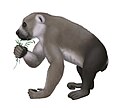 Gorilla lemur |
Archaeoindris fontoynontii | Central Madagascar | Extinct (c. 350 BC) |  Lorisoids |
 Baboon lemurs |
Archaeolemur spp. Hadropithecus spp. |
Madagascar | Extinct (before AD 1280) | |
 Sloth lemurs |
Babakotia spp. Palaeopropithecus spp. |
Western and Central Madagascar | Extinct (c. AD 1500) | |
 Koala lemurs |
Megaladapis edwardsi M. grandidieri M. madagascariensis |
Madagascar | Extinct (AD 1280–1420) |
Carnivorans
| Example | Binomial name | Native range | Current status | Continental relative |
|---|---|---|---|---|
 Sardinian giant otter |
Megalenhydris barbaricina | Sardinia | Extinct (Late Pleistocene) |  Otters |
 Fossa |
Cryptoprocta ferox | Madagascar | Vulnerable |  Mongooses |
Giant fossa |
Cryptoprocta spelaea | Madagascar | Extinct (before AD 1400) |
Birds
Stem birds
| Example | Binomial name | Native range | Current status | Continental relative |
|---|---|---|---|---|
 Balaur |
B. bondoc | Hateg Island |
Extinct (Late Cretaceous) |  Jeholornis[19] |
 Gargantuavis |
G. philohinos | Ibero-Armorican Island | Extinct (Late Cretaceous) |  Patagopteryx (?) |
Ratites
| Example | Binomial name | Native range | Current status | Continental relative |
|---|---|---|---|---|
 Kiwis |
Apterygidae | New Zealand | Variable | Proapteryx[b] |
 Greater elephant birds |
Aepyornithidae |
Madagascar | Extinct (c. AD 1700) | |
 Lesser elephant birds |
Mullerornithidae | Madagascar | Extinct (c. AD 1260) | |
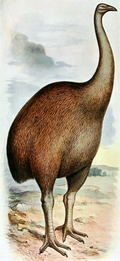 Giant moas |
Dinornithidae |
New Zealand | Extinct (c. AD 1450) |  Tinamous |
 Lesser moas |
Emeidae | New Zealand | Extinct (c. AD 1460) | |
 Upland moas |
Megalapterygidae | New Zealand | Extinct (c. AD 1300) |
Waterfowl
| Example | Binomial name | Native range | Current status | Continental relative |
|---|---|---|---|---|
| New Zealand musk duck | Biziura delautouri | New Zealand | Extinct (after AD 1500) |  Australian musk duck |
New Zealand geese |
Cnemiornis calcitrans C. gracilis |
New Zealand | Extinct |  Cape Barren goose |
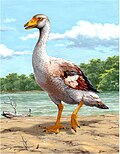 Garganornis |
G. ballmanni | Gargano and Scontrone islands |
Extinct (Late Miocene) | Geese[21]
|
 Turtle-jawed moa-nalo |
Chelychelynechen quassus | Kauai | Extinct (c. AD 1000) | Dabbling ducks
|
 Small-billed moa-nalo |
Ptaiochen pau | Maui | Extinct (c. AD 1000) | |
 Large-billed moa-nalo |
Thambetochen chauliodous | Maui Nui | Extinct (c. AD 1000) | |
O'ahu moa-nalo |
Thambetochen xanion | O'ahu |
Extinct (c. AD 1000) | |
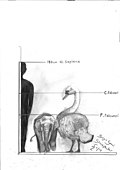 Giant swan |
Cygnus falconeri | Sicily and Malta | Extinct ( Middle Pleistocene ) |
 Mute swan |
| Scarlett's duck | Malacorhynchus scarletti | New Zealand | Extinct (after AD 1500) |  Pink-eared duck |
Pangalliformes
| Example | Binomial name | Native range | Current status | Continental relative |
|---|---|---|---|---|
| Pile-builder megapode | Megapodius molistructor | New Caledonia and Tonga | Extinct (c. 1500 BC) |  Scrubfowl |
| Megavitiornis | Megavitiornis altirostris | Fiji | Extinct |  Galliformes |
 Sylviornis |
Sylviornis neocaledoniae | Isle of Pines |
Extinct |
Gruiformes
| Example | Binomial name | Native range | Current status | Continental relative |
|---|---|---|---|---|
 Red rail |
Aphanapteryx bonasia | Mauritius | Extinct (c. AD 1700) |  Rails |
 Hawkins' rail |
Diaphanapteryx hawkinsi | Chatham Islands | Extinct (c. AD 1900) | |
 Antillean cave rail |
Nesotrochis debooyi | Puerto Rico and Virgin Islands | Extinct | |
| Cuban cave rail | Nesotrochis picapicensis | Cuba | Extinct | |
| Haitian cave rail | Nesotrochis steganinos | Hispaniola | Extinct | |
South Island takahē |
Porphyrio hochstetteri | South Island, New Zealand | Endangered | |
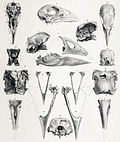 North Island takahē |
Porphyrio mantelli | North Island, New Zealand | Extinct (before AD 1900) | |
 Adzebills |
Aptornis defossor A. otidiformis |
New Zealand | Extinct |  Madagascar flufftail[22] |
 Chatham coot |
Fulica chathamensis | Chatham Islands | Extinct (after AD 1500) |  Red-knobbed coot and other coots |
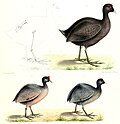 Mascarene coot |
Fulica newtonii | Mauritius and Réunion | Extinct (c. AD 1700) | |
| New Zealand coot | Fulica prisca | New Zealand | Extinct (after AD 1280) | |
 Réunion swamphen |
Porphyrio coerulescens | Plaine des Cafres, Réunion | Extinct (c. AD 1730) |  Purple swamphens |
Pigeons
| Example | Binomial name | Native range | Current status | Continental relative |
|---|---|---|---|---|
 Viti Levu giant pigeon |
Natunaornis gigoura | Viti Levu, Fiji | Extinct |  Crowned pigeons |
| Kanaka pigeon | Caloenas canacorum | New Caledonia | Extinct (c. 500 BC) |  Nicobar pigeon |
 Rodrigues solitaire |
Pezophaps solitaria | Rodrigues | Extinct (before AD 1778) | |
 Dodo |
Raphus cucullatus | Mauritius | Extinct (c. AD 1662) |
Birds of prey
| Example | Binomial name | Native range | Current status | Continental relative |
|---|---|---|---|---|
| Liko Cave golden eagle | Aquila chrysaetos simurgh | Crete | Extinct (Late Pleistocene) |  Golden eagle |
| Giant crab-hawk[23] | Buteogallus borrasi | Cuba | Extinct |  Great black hawk and other hawks |
| Giant hawk | Gigantohierax sp. | Cuba | Extinct | |
| Titan-hawk | Titanohierax gloveralleni | Bahamas |
Extinct | |
| Jamaican caracara | Caracara tellustris | Jamaica | Extinct |  Caracaras |
| Eyles' harrier | Circus eylesi | New Zealand | Extinct (c. AD 1000) |  Swamp harrier |
 Gargano Island eagles |
Garganoaetus freudenthali G. murivorus |
Gargano Island |
Extinct (Late Miocene) | Aquila delphinensis
|
 Haast's eagle |
Hieraaetus moorei | New Zealand | Extinct (c. AD 1400) |  Little eagle |
 Philippine eagle |
Pithecophaga jefferyi | Philippines | Critically endangered |  Bateleur[24] |
Parrots
| Example | Binomial name | Native range | Current status | Continental relative |
|---|---|---|---|---|
 Hercules parrot |
Heracles inexpectatus | New Zealand | Extinct (Miocene) |  Other parrots |
 Kakapo |
Strigops habroptilus | New Zealand | Critically Endangered | |
 Broad-billed parrot |
Lophopsittacus mauritianus | Mauritius | Extinct (c. AD 1680) | 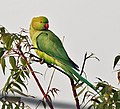 Psittaculine parrots |
Owls
| Example | Binomial name | Native range | Current status | Continental relative |
|---|---|---|---|---|
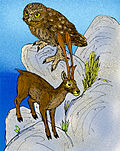 Cretan owl |
Athene cretensis | Crete | Extinct (Pleistocene) |  Little owl |
Cuban giant owls |
Ornimegalonyx spp. | Cuba | Extinct (Pleistocene) | Wood owls
|
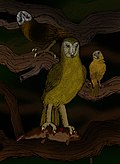 Greater Gargano giant owl |
Tyto gigantea | Gargano Island |
Extinct (Late Miocene) | 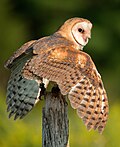 Barn owls |
 Andros Island barn owl |
Tyto pollens | Bahamas |
Extinct (before AD 1600) | |
 Rivero's barn owl |
Tyto riveroi | Cuba | Extinct | |
 Lesser Gargano giant owl |
Tyto robusta | Gargano Island |
Extinct ( Early Pliocene )
|
Caprimulgiformes
| Example | Binomial name | Native range | Current status | Continental relative |
|---|---|---|---|---|
| New Zealand owlet-nightjar | Aegotheles novazelandiae | New Zealand | Extinct (c. AD 1200) |  Australian owlet-nightjar |
 New Caledonian owlet-nightjar |
Aegotheles savesi | New Caledonia | Critically endangered |
Passeriforms
| Example | Binomial name | Native range | Current status | Continental relative |
|---|---|---|---|---|
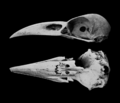 Chatham raven |
Corvus moriorum | Chatham Islands | Extinct | New Zealand raven |
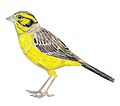 Long-legged bunting |
Emberiza alcoveri | Tenerife | Extinct (after AD 1) |  Cabanis's bunting |
Giant nukupu'u |
Hemignathus vorpalis | Hawaii | Extinct (after AD 1000) |  Finches |
| Tasmanian superb fairywren | Malurus cyaneus cyaneus | Tasmania | Least Concern |  Superb fairywren |
| Kangaroo Island superb fairywren | Malurus cyaneus ashbyi | Kangaroo Island | Least Concern | |
Stout-legged wren |
Pachyplichas yaldwyni | South Island of New Zealand | Extinct |  Other passeriforms |
 St Kilda wren |
Troglodytes troglodytes hirtensis | St Kilda, Scotland | Unknown |  Eurasian wren |
 Capricorn silvereye |
Zosterops lateralis chlorocephalus | Capricorn and Bunker Group of the Australian Great Barrier Reef | Unknown |  Silvereye |
Reptiles
Pterosaurs
| Example | Binomial name | Native range | Current status | Continental relative |
|---|---|---|---|---|
 Hatzegopteryx |
H. thambema | Hateg Island |
Extinct (Late Cretaceous) |  Quetzalcoatlus |
Iguanids
| Example | Binomial name | Native range | Current status | Continental relative | Insular / mainland length or mass ratio |
|---|---|---|---|---|---|
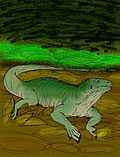 Tongan giant iguana[25] |
Brachylophus gibbonsi | Tonga | Extinct (c. 800 BC) |  South American iguanas |
|
 Fijian giant iguana [26] |
Lapitiguana impensa |
Fiji | Extinct (c. 1000 BC) | ||
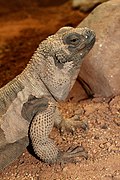 Angel Island chuckwalla |
Sauromalus hispidus | Isla Ángel de la Guarda, Baja California | Near Threatened | Peninsular chuckwalla |
MR ≈ 5 [27] |
 San Esteban chuckwalla |
Sauromalus varius | San Esteban Island, Baja California | Endangered | MR ≈ 5 [27] |
Geckos
| Example | Binomial name | Native range | Current status | Continental relative | Insular / mainland length or mass ratio |
|---|---|---|---|---|---|
Delcourt's giant gekko |
Gigarcanum delcourti | New Caledonia | Extinct (c. AD 1870) |  Diplodactylid geckos |
LR ≈ 6.75 [c] |
New Caledonian giant gecko |
Rhacodactylus leachianus | New Caledonia | Least Concern | LR ≈ 4.4 [d] MR ≈ 60 [e] | |
Rodrigues giant day gecko |
Phelsuma gigas | Rodrigues | Extinct (c. AD 1850) |  Day geckos |
Skinks
| Example | Binomial name | Native range | Current status | Continental relative |
|---|---|---|---|---|
 Vaillant's mabuya |
Chioninia vaillanti | Cape Verde | Endangered | mabuyine skinks
|
 Cape Verde giant skink |
Macroscincus coctei | Cape Verde | Extinct (after AD 1900) | |
Mauritius giant skink |
Leiolopisma mauritiana | Mauritius | Extinct (after AD 1600) | Mainland eugongyline skinks
|
| Terror skink | Phoboscincus bocourti | Île des Pins off New Caledonia |
Endangered | eugongyline skinks
|
| Kishinoue's giant skink | Plestiodon kishinouyei | Miyako Islands and Yaeyama Islands, Japan | Vulnerable |  Asian Plestiodon spp. |
Wall lizards
| Example | Binomial name | Native range | Current status | Continental relative |
|---|---|---|---|---|
| La Palma giant lizard | Gallotia auaritae | La Palma | Critically endangered |  Mediterranean sandrunner lizards |
 La Gomera giant lizard |
Gallotia bravoana | Gomera |
Critically endangered | |
 Tenerife giant lizard[31] |
Gallotia goliath | Tenerife | Extinct (c. AD 1500) | |
 El Hierro giant lizard |
Gallotia simonyi | El Hierro | Critically endangered | |
 Gran Canaria giant lizard |
Gallotia stehlini | Gran Canaria | Least Concern |
Snakes
| Example | Binomial name | Native range | Current status | Continental relative |
|---|---|---|---|---|
Angel de la Guarda Island speckled rattlesnake |
Crotalus mitchellii angelensis | Isla Ángel de la Guarda off Baja California | Least Concern |  Speckled rattlesnake |
| Tadanae-jima striped snake population[32] | Elaphe quadrivirgata | Tadanae-jima island off Tokyo | Unknown |  Japanese striped snake |
 Island tiger snake populations |
Notechis scutatus | Islands Mount Chappell (Tasmania); Williams, Hopkins, and the Nuyts Archipelago (all South Australia)[33] | Least Concern[34] |  Tiger snake |
| Isla Cerralvo long-nosed snake | Rhinocheilus lecontei etheridgei | Jacques Cousteau Island off Baja California Sur | Unknown |  Long-nosed snake |
Dubious examples

- The mammalian competition. However, these lizards are not as large as their extinct Australian relative megalania, and it has been proposed based on fossil evidence that the ancestors of these varanids first evolved their large size in Australia and then dispersed to Indonesia.[35] If this is true, rather than being insular giants they would be viewed as examples of phyletic gigantism. Supporting this interpretation is evidence for a lizard in Pliocene India, Varanus sivalensis, comparable in size to V. komodoensis.[35] Nevertheless, given that Australia is often described as the world's largest islandand that the related megalania, the largest terrestrial lizard known in the fossil record, was restricted to Australia, the perception of the largest Australasian/Indonesian lizards as insular giants may still have some validity.
- Giant tortoises in the Galápagos Islands and the Seychelles, the largest extant tortoises, as well as extinct tortoises of the Mascarenes and Canary Islands, are often considered examples of island gigantism. However, during the Pleistocene, comparably sized or larger tortoises were present in Australia (Meiolania), southern Asia (Megalochelys), Europe[36] (Titanochelon), Madagascar (Aldabrachelys), North America[37] (Hesperotestudo) and South America[38] (Chelonoidis, the same genus now found in the Galápagos[39]), and on a number of other, more accessible islands of Oceania and the Caribbean.[37] In the late Pliocene they were also present in Africa ("Geochelone" laetoliensis[40]). The present situation of large tortoises being found only on remote islands appears to reflect that these islands were discovered by humans recently and have not been heavily populated, making their tortoises less subject to overexploitation.
Amphibians
| Example | Binomial name | Native range | Current status | Continental relative | Insular / mainland length or mass ratio |
|---|---|---|---|---|---|
| São Tomé giant tree frog | Hyperolius thomensis[41] | São Tomé Island | Endangered |  African reed frogs |
|
| Palm forest tree frog | Leptopelis palmatus[41] | Príncipe Island | Vulnerable |  Red tree frog |
LR ≈ 1.2 [f] |
| Giant Fiji ground frog | Platymantis megabotoniviti[44] | Viti Levu, Fiji | Extinct |  Asian platymantines |
|
| São Tomé giant grass frog | Ptychadena newtoni[41] | São Tomé Island | Endangered |  Mascarene grass frog |
Arthropods
| Example | Binomial name | Native range | Current status | Continental relative |
|---|---|---|---|---|
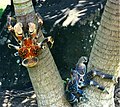 Coconut crab |
Birgus latro | Indian Ocean islands and Polynesia[45] |
Vulnerable |  Coenobita hermit crabs |
 Giant weta |
Deinacrida spp. | New Zealand | Variable |  South African king crickets |
| Giant pseudoscorpion[46] | Garypus titanius | Boatswain Bird Island | Critically Endangered | Garypoids
|
Hissing cockroaches |
Gromphadorhini spp. | Madagascar | Unknown |  Blaberids |
 Saint Helena earwig |
Labidura herculeana | Saint Helena | Extinct (c. AD 1967) | 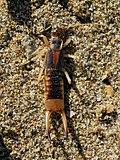 Shore earwig |
 Wallace's giant bee |
Megachile pluto | North Moluccas | Vulnerable |  Callomegachile |
 Megalara |
Megalara garuda | Mekongga Mountains, Sulawesi |
Unknown |  Crabronine wasps |
 Madagascan giant pill-millipedes |
Microsphaerotherium spp. Sphaeromimus spp. Zoosphaerium spp. |
Madagascar | Unknown |  Indian giant pill-millipedes (Arthrosphaera) |
 Orsonwelles |
Orsonwelles spp. | Hawaii | Unknown |  Money spiders |
Conant's giant Nihoa tree cricket |
Thaumatogryllus conanti | Nihoa | Unknown |  Tree crickets |
 Giant Fijian long-horned beetle[47] |
Xixuthrus heros | Viti Levu, Fiji | Endangered |  Australasian Xixuthrus |
| Taveuni beetle | Xixuthrus terribilis | Taveuni, Fiji | Unknown |
Gastropods
| Example | Binomial name | Native range | Current status | Continental relative |
|---|---|---|---|---|
 Kauri land snails |
Paryphanta spp. Powelliphanta spp. |
New Zealand | Near Threatened |  Other rhytidids |
Flora
In addition to size increase, island plants may also exhibit "insular woodiness".
| Example | Binomial name | Native range | Current status | Continental relative |
|---|---|---|---|---|
Campbell Island carrot |
Anisotome latifolia | Campbell and Auckland Islands | Unknown |  Apiaceae |
Ross lily |
Bulbinella rossii | Campbell and Auckland Islands | Naturally Uncommon | 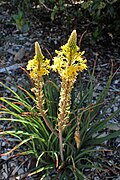 New Zealand Maori lily |
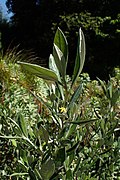 Chatham Islands korokio[49][50] |
Corokia macrocarpa | Chatham Islands | Unknown |  New Zealand korokio[51] |
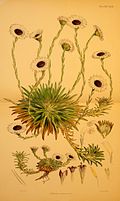 Black-eyed daisy |
Damnamenia vernicosa | Auckland and Campbell Islands | Naturally Uncommon |  Astereae |
 Cucumber tree[52] |
Dendrosicyos socotranus |
Socotra | Vulnerable |  Gourds |
| Lodoicea maldivica | Seychelles | Endangered |  Borassoid palms | |
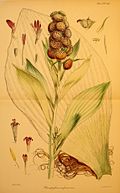 |
Pleurophyllum criniferum | Antipodes, Auckland and Campbell Islands | Unknown |  Cineraria |
 Silver-leaf daisy |
Pleurophyllum hookeri | Macquarie Island, Auckland and Campbell Islands | Unknown | |
Campbell Island daisy |
Pleurophyllum speciosum | Campbell and Auckland Islands | Naturally Uncommon | |
Macquarie Island cabbage |
Stilbocarpa polaris | New Zealand subantarctic islands |
Vulnerable |  Araliaceae |
See also
- Deep-sea gigantism
- Island tameness
- Insular dwarfism
- Megafauna
- Pleistocene extinctions
Notes
- ^ The reduction in predation on islands often also leads to tamer behavior of island prey species, a trend that has been analyzed in lizards.[2][3]
- ^ The earliest known New Zealand kiwi ancestor, a presumed recent arrival from Australia.[20]
- ^ Based on the estimated total length of H. delcourti, ~23.6 in,[28] and the average length of a member of Diplodactylus, the most species-rich genus of Australian diplodactylid geckos, ~3.5 in.[29]
- ^ Based on the average total length of the larger subspecies, R. l. leachianus, ~15.5 in,[30] and the average length of a member of Diplodactylus, the most species-rich genus of Australian diplodactylid geckos, ~3.5 in.[29]
- ^ Based on the average mass of the larger subspecies, R. l. leachianus, ~240 g,[30] with the average weight of a member of Diplodactylus, the most species-rich genus of Australian diplodactylid geckos, ~4 g.[29]
- ^ Based on the average female snout to vent length (SVL) of L. palmatus, ~96 mm,[42] with the average female SVL of L. rufus, ~80 mm.[43]
References
- S2CID 205782326.
- PMID 24403345.
- S2CID 183158746.
- PMID 21270022.
- hdl:10553/19918.
- ^ S2CID 26853128.
- .
- S2CID 85866114.
- ^ Filin, I.; Ziv, Y. (2004). "New Theory of Insular Evolution: Unifying the Loss of Dispersability and Body-mass Change" (PDF). Evolutionary Ecology Research. 6: 115–124. Archived from the original (PDF) on 2020-01-25. Retrieved 2014-11-18.
- .
- S2CID 135302585.
- ^ Freudenthal, M. (1985). Cricetidae (Rodentia) from the Neogene of Gargano (Prov. of Foggia, Italy). Rijksmuseum van Geologie en Mineralogie.
- ^ "St Kilda's 'super-sized' field mice studied". BBC. 2010-09-03. Retrieved 2020-03-02.
- ^ "Error" (PDF).
- hdl:1808/20678.
- ^ http://www.raco.cat/index.php/Orsis/article/viewFile/24434/24268 [bare URL PDF]
- ^ Daams, R.; Freudenthal, M. (1985). "Stertomys laticrestatus, a new glirid (dormice, Rodentia) from the insular fauna of Gargano (Prov. of Foggia, Italy)". Scripta Geologica. 77: 21–27.
- ^ S2CID 55615855.)
{{cite journal}}: CS1 maint: multiple names: authors list (link - ^ "Late Cretaceous Animals of Romania's Haţeg Island--a More Complex View".
- ^ Worthy, Trevor H.; et al. (2013). Miocene fossils show that kiwi (Apteryx, Apterygidae) are probably not phyletic dwarves (PDF). Paleornithological Research 2013, Proceedings of the 8th International Meeting of the Society of Avian Paleontology and Evolution. Retrieved 16 September 2017.
- PMID 28280574.
- ^ "African Origins for the Enigmatic Adzebill".
- ^ Naish, Darren (2008-01-28). "Titan-hawks and other super-raptors". Tetrapod Zoology blog. ScienceBlogs LLC. Retrieved 2011-03-02.
- PMID 15925523.
- S2CID 85627049.
- S2CID 85804786.
- ^ S2CID 22032248.
- OCLC 937349394.
- ^ a b c Stewart, C. (9 May 2014). "Diplodactylus Geckos of Australia". reptilesmagazine.com/. Retrieved 2020-02-29.
- ^ a b Bergman, J.; Hamper, R. (2016). "New Caledonian Giant Gecko Care Sheet". reptilesmagazine.com/. Retrieved 2020-02-29.
- .
- ^ https://www.jstage.jst.go.jp/article/hsj2000/21/1/21_1_43/_pdf [bare URL PDF]
- S2CID 58524.
- ^ Michael, D.; Clemann, N.; Robertson, P. (2018). "Notechis scutatus". IUCN Red List of Threatened Species. 2018: e.T169687A83767147. Retrieved 19 December 2019.
- ^ PMID 19789642.
- ^ Pérez-García, A., Vlachos, E., & Arribas, A. (2017). The last giant continental tortoise of Europe: A survivor in the Spanish Pleistocene site of Fonelas P-1. Palaeogeography, Palaeoclimatology, Palaeoecology, 470, 30–39.
- ^ . Retrieved 2012-03-02.
- ISSN 1514-5158.
- ^ Fariña, R.A., Vizcaíno, S.F. & De Iuliis, G. (2013) Megafauna: Giant Beasts of South America. Indiana University Press, 448 pages.
- ISBN 978-90-481-9961-7.
- ^ S2CID 17562846.
- ^ "Leptopelis palmatus". amphibiaweb.org. University of California, Berkeley. 2008. Retrieved 29 February 2020.
- ^ "Leptopelis rufus". amphibiaweb.org. University of California, Berkeley. 2008. Retrieved 29 February 2020.
- .
- ^ Neither coconut crabs nor their relatives can swim beyond the larva stage, making the adults land animals in practice. Coconut crabs can weigh over 4 kg (9 pounds); the largest hermit crabs of the related genus Coenobita, C. brevimanus of coastal Africa and Asia, only reaches 230 grams (0.5 pounds).
- ^ "Ascension Island Biodiversity Action Plan: Garypus titanius species action plan" (PDF). Georgetown, Ascension Island: Ascension Island Government Conservation Department. 2015-02-26. Archived from the original (PDF) on 2020-09-20. Retrieved 2019-09-11.
- S2CID 86478177.
- S2CID 83497517.
- ^ a b "Small islands breed big seeds".
- ^ "Website Not Available".
- ^ "T.E.R:R.A.I.N - Taranaki Educational Resource: Research, Analysis and Information Network - Corokia cotoneaster (Korokio)".
- ^ S2CID 186536407.
- OCLC 906429733.

